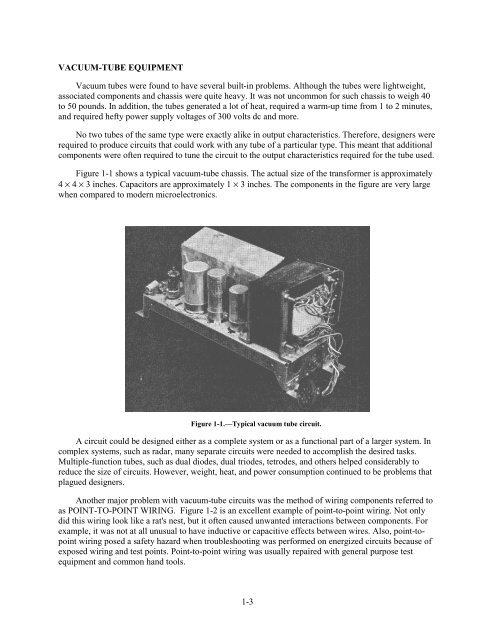Navy Electricity and Electronics Training Series - Historic Naval ...
Navy Electricity and Electronics Training Series - Historic Naval ...
Navy Electricity and Electronics Training Series - Historic Naval ...
You also want an ePaper? Increase the reach of your titles
YUMPU automatically turns print PDFs into web optimized ePapers that Google loves.
VACUUM-TUBE EQUIPMENTVacuum tubes were found to have several built-in problems. Although the tubes were lightweight,associated components <strong>and</strong> chassis were quite heavy. It was not uncommon for such chassis to weigh 40to 50 pounds. In addition, the tubes generated a lot of heat, required a warm-up time from 1 to 2 minutes,<strong>and</strong> required hefty power supply voltages of 300 volts dc <strong>and</strong> more.No two tubes of the same type were exactly alike in output characteristics. Therefore, designers wererequired to produce circuits that could work with any tube of a particular type. This meant that additionalcomponents were often required to tune the circuit to the output characteristics required for the tube used.Figure 1-1 shows a typical vacuum-tube chassis. The actual size of the transformer is approximately4 × 4 × 3 inches. Capacitors are approximately 1 × 3 inches. The components in the figure are very largewhen compared to modern microelectronics.Figure 1-1.—Typical vacuum tube circuit.A circuit could be designed either as a complete system or as a functional part of a larger system. Incomplex systems, such as radar, many separate circuits were needed to accomplish the desired tasks.Multiple-function tubes, such as dual diodes, dual triodes, tetrodes, <strong>and</strong> others helped considerably toreduce the size of circuits. However, weight, heat, <strong>and</strong> power consumption continued to be problems thatplagued designers.Another major problem with vacuum-tube circuits was the method of wiring components referred toas POINT-TO-POINT WIRING. Figure 1-2 is an excellent example of point-to-point wiring. Not onlydid this wiring look like a rat's nest, but it often caused unwanted interactions between components. Forexample, it was not at all unusual to have inductive or capacitive effects between wires. Also, point-topointwiring posed a safety hazard when troubleshooting was performed on energized circuits because ofexposed wiring <strong>and</strong> test points. Point-to-point wiring was usually repaired with general purpose testequipment <strong>and</strong> common h<strong>and</strong> tools.1-3

















